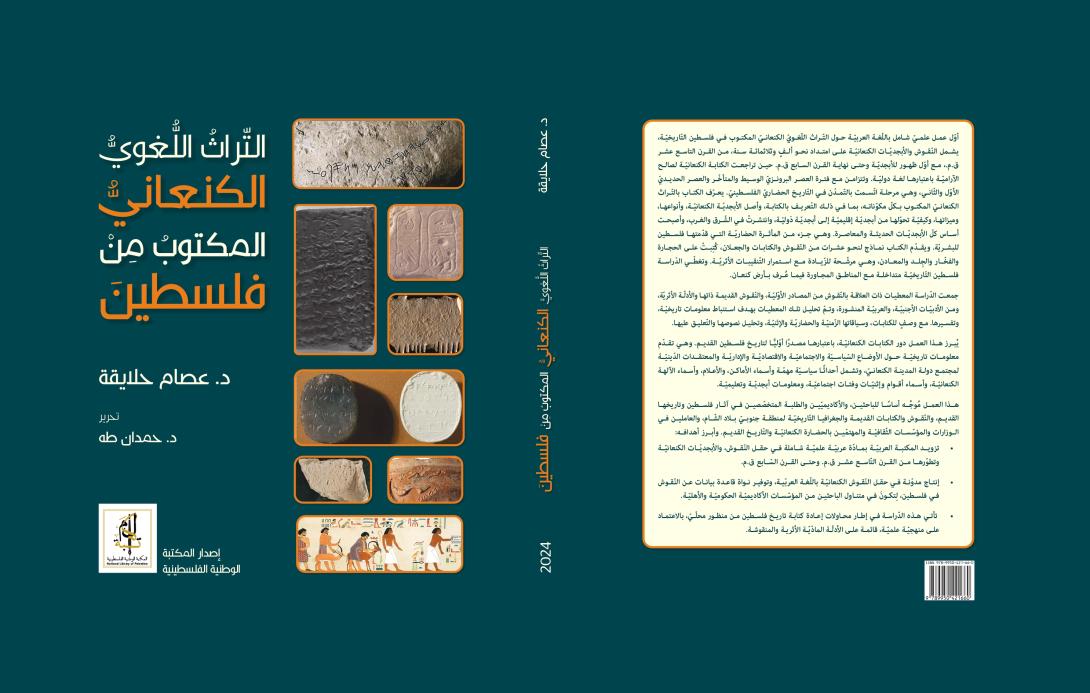
The first publication of the National Library of Palestine
The National Library of Palestine issues a book about the Canaanite linguistic heritage in Palestine
Ramallah-National Library: The National Library of Palestinemakes its first mark in the world of publishing by issuing a book that explores the Canaanite linguistic heritage in Palestine.
The book is titled “The Written Canaanite Linguistic Heritage from Palestine” and is written by the Head of the Department of History and Archeology at Birzeit University, Dr. Issam Al-Halayqa, edited by the independent researcher in archaeology, Dr. Hamdan Taha, it comes in 440 large pages, and includes an introduction and seven chapters about the Canaanite inscriptions from Palestine and its cultural and ethnic framework. The book is provided with more than 206 illustrative models, such as pictures, maps, tables, and indexes.
The National Library confirmed that this book represents the first comprehensive scientific work in the Arabic language about the written Canaanite linguistic heritage in historical Palestine. It includes Canaanite inscriptions and alphabets over a period of about one thousand three hundred years from the nineteenth century BC with the first appearance of the alphabet, until the end of the seventh century BC when Canaanite writing declined in favor of Aramaic as an international language, and coincides with the period of the Middle and Late Bronze Age and the First and Second Iron Ages, a stage characterized by urbanization in Palestinian cultural history.
Furthermore, the book introduces the written Canaanite heritage with all its components, including the definition of writing, the origin of the Canaanite alphabet (its types and features), and how it transformed from a regional alphabet into an international alphabet, which led to its spread in the East and West and became the basis of all modern and contemporary alphabets, and it is part of the cultural impact that Palestine has provided to humanity.
It also presents dozens of examples of inscriptions, writings, and scarabs written on stones, pottery, leather, and metals, and they are likely to increase as archaeological excavations continue. The study covers historical Palestine and is intertwined with neighboring regions in what was known as the Land of Canaan.
The study collected data related to the inscriptions from primary sources, ancient inscriptions themselves, archaeological evidence, and published foreign and Arab literature. This data was analyzed with the aim of deriving and interpreting historical information, with a description of the writings, their temporal, cultural and ethnic contexts, and analyzing their texts and commenting on them.
This work highlights the role of Canaanite writings, as a primary source for the ancient history of Palestine. It provides historical information about the political, social, economic, and administrative conditions and religious beliefs of the Canaanite city-state community. It also includes important political events, names of places, flags, names of Canaanite gods, and names of (peoples, ethnicities, and social groups) and alphabetical and educational information.
Dr. Hamdan Taha, in his presentation of the book, confirmed that the inscriptions and writings provide an important source for defining the historical geography of Palestine, since they mentioned the names of ancient Palestine: Upper Retno, Lower Retno, Jahi, and Canaan, as well as the names of the ancient cities in the context of Egyptian military campaigns against Canaan and trade exchanges in Egyptian cursing texts from the eighteenth century BC, and in the record of the campaign of Tuthmosis III and Ramses. many writings also described the natural landscape in Palestine, such as the story of the Egyptian officer Sinuhe which provided a vivid description of the natural landscape in Palestine, describing its topography, agriculture, fruits, and the customs of its inhabitants.
This work constitutes a valuable reference for researchers, academics and students specializing in the antiquities of Palestine and its ancient history, ancient inscriptions and writings, and the historical geography of the southern Levant region, it also serves workers in ministries and cultural institutions and those interested in the Canaanite civilization and ancient history.
This study comes in an attempt to rewrite the history of Palestine from a local perspective, relying on a scientific methodology, based on archaeological and inscribed material evidence, and aspires to provide the Arab Library with comprehensive scientific Arabic material in the field of inscriptions and Canaanite alphabets and their development from the nineteenth century BC. until the seventh century BC. In addition to producing a blog in the field of Canaanite inscriptions in the Arabic language, and providing a primary database on inscriptions in Palestine, in order to be accessible to researchers from governmental and private academic institutions.
The issuance of this book comes within the efforts of the National Library of Palestine to enhance the cultural and linguistic heritage in historical Palestine, and represents a promising beginning for a series of distinguished publications that aim to shed light on the ancient and modern history of Palestine.
